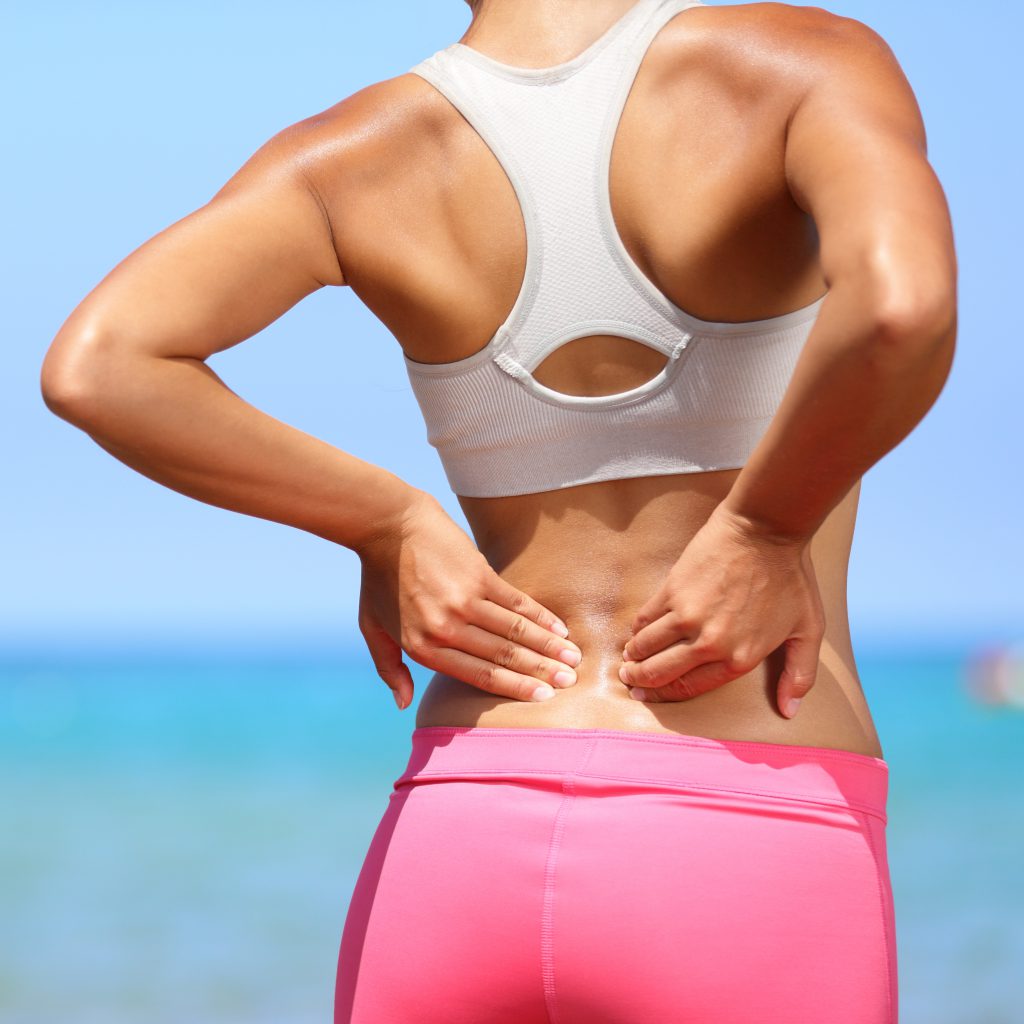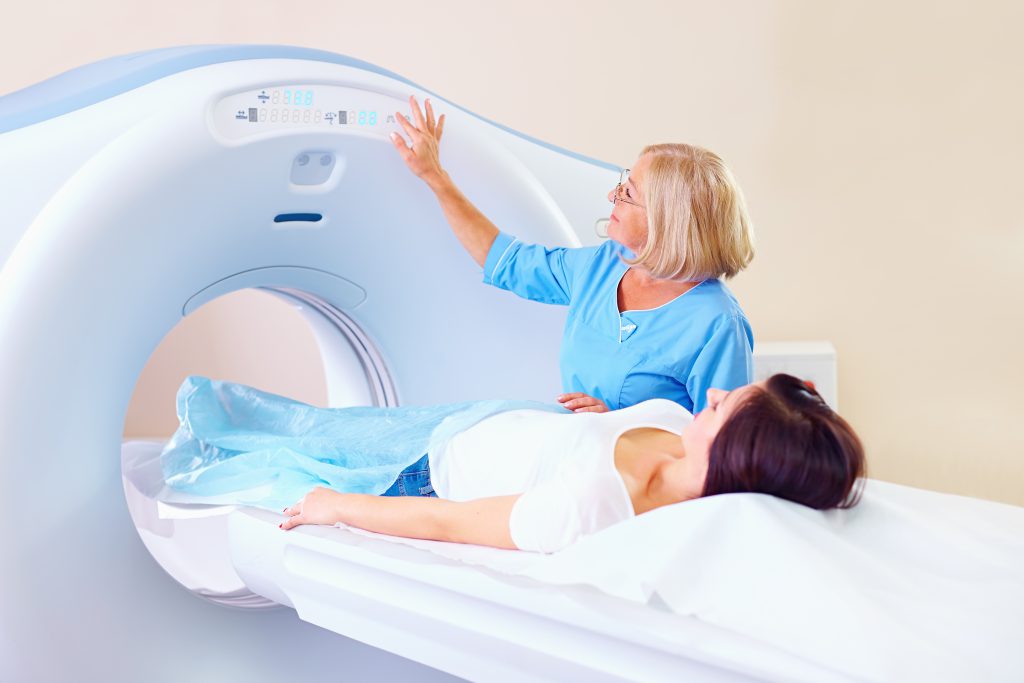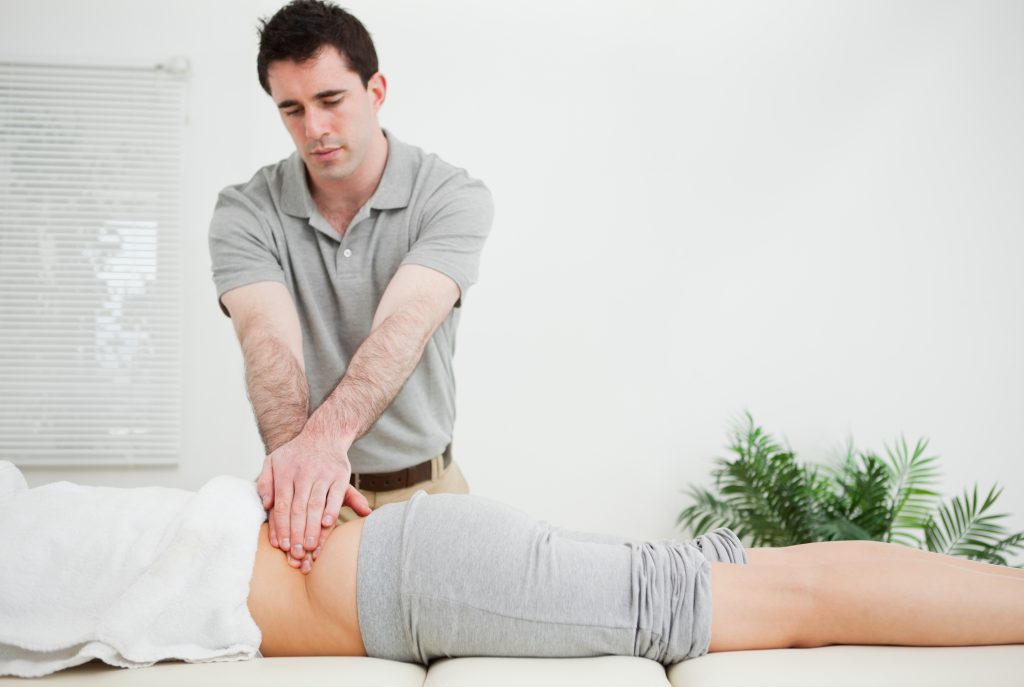Low Back Pain (Lumbago)

What is Lumbago?
Lumbago or (Low back pain) is a common term used to describe stiffness and pain in the lumbar or lower portion of the back. Sometimes people refer to this area as the “small” of the back. Sometimes when Lumbago occurs, pain that radiates into the buttocks or legs is present as well.
Simple changes in posture and positioning, in combination with exercise, can often help relieve Lumbago. In some cases, physical therapy, prescription medications or surgery may be required.

Ring-shaped bones are known as vertebra form the spine. These bones are stacked on top of one another to form a strong column. This column keeps the body sturdy and enables it to stand upright. In between each bony vertebra is a disc with a tough outer edge and a gel-like center. These vertebral discs function as cushions between the vertebrae. Tissues and muscles help to hold the vertebrae in the correct position.
The lumbar or lower back area of the spine is made up of five vertebrae. These five vertebrae form the area of the low back where the spine curves inward.
Lumbago may be the result of a problem with any of these structures.
The basic reasons for Lumbago can be perplexing and are not generally promptly clear. While deciding the fundamental reason for bringing down Lumbago, two primary components help manage the doctor in making a preparatory determination:
- The type of low back pain – meaning a portrayal of how the pain feels, what aggravates it better or, when it happens, and
- The range of pain dissemination – meaning where the pain is felt, in the event that it is restricted to the low back, or if the going with leg pain is worse than Lumbago, or if the pain transmits somewhere else in the body.
Reasons
In the greater part of cases, it is difficult to distinguish the correct reason for Lumbago.
There may, for instance, have been minor strains or tears of a portion of the smaller muscles and tendons, which can be hard to pinpoint inside the intricate structure that is the human back.
In around 25% of cases, a particular issue can be found.
Frequently, these patients are experiencing conditions like joint pain of minor joints called feature joints between the vertebral bones, a slipped disc (prolapse of an intervertebral discs), a crumple or break of at least one vertebrae (this is more probable in more established patients particularly when they have fallen or there is osteoporosis or weak bones), twisting of common spine bend (scoliosis) or all the more once in a while, skeletal harm because of tumors or contamination.
There are many causes of Lumbago, but the most common reason it occurs is that of an injury. The muscles or connective tissues can be hurt by stretching or by incorrectly carrying or lifting heavy objects. Back muscles can also become weak due to inactivity. Exercises to help strengthen the muscles in the abdomen and back can help reduce Lumbago.
In addition to injuries, there are other factors that can cause or contribute to Lumbago.
They include:
- - Incorrect posture, or sitting or standing in one position for an extended amount of time
- - Obesity can contribute to low back pain
- - Osteoporosis: A condition that causes bones to become brittle or thin
- - Osteoarthritis can cause low back pain
- - A “slipped” disc: this condition occurs when part of the gel-like center of a vertebral disc herniates or bulges out, and presses on a nerve, causing low back pain
- - Fibromyalgia: a condition that is characterized by sore and achy muscles, easy fatigue and many times, headaches
Lumbago can also be the result of other medical conditions such as infections, cancer or other serious illnesses but this is uncommon.
Risk Factors
Maturing. After some time, wear and tear on the spine that may bring about conditions (e.g., disc degeneration, spinal stenosis) that deliver neck and back pain. This implies individuals over age 30 or 40 are more in danger of back pain than more youthful people. Individuals, age 30 to 60 will probably have discs related disarranges, while individuals over age 60 will probably have pain identified with osteoarthritis.
Hereditary qualities. There is some proof that specific sorts of the spinal issue have a hereditary segment. For instance, degenerative discs infection appears to have an acquired part.
Word related risks. Any occupation that requires constant crouching and heavy lifting have a high frequency of back damage. Occupations that require extending periods of time of remaining without a break or sitting in a seat that does not bolster the back well additionally puts the individual at more serious hazard.
Lower Back Pain Diagnosis and Symptoms
To accurately conduct lower back pain diagnosis, many physicians begin by completing a physical examination. This helps them determine where your pain is located and if your mobility has been affected. Your physician may also check your response to sensation and your reflexes as a lower back pain diagnosis to help determine if your nerves have been from by the problem that is causing your low back pain.
Symptoms
Unless you have lower back pain symptoms that are disabling or are concerning, your physician will probably want you to try self-care treatments for the pain. They will monitor your symptoms and condition for a few weeks before sending you for more extensive testing and lower back pain diagnosis. The reason for this is because most cases of low back pain resolve by using conservative treatment.
Contingent upon the reason for lower back pain diagnosis, the beginning of indications can fluctuate broadly. Back pain may include:
- 1. Pain that grows gradually after some time. Manifestations caused by monotonous movements or stress-actuating positions tend to go ahead gradually and logically compound. Pain may create after specific exercises or toward the finish of a difficult day and may feel like a consistent hurt.
- 2. Pain that travels in multiple directions, however, declines after some time. Low back pain caused by degenerative disc ailment can be felt now and again, however pain flare-ups get logically more extreme over a drawn-out stretch of time.
- 3. Quick pain after damage. Sudden or jolting developments can harm the spine and its strong muscles, causing quick, intense pain.
- 4. Deferred side effects after damage. Occasionally side effects create or deteriorate a couple of hours or days after a mischance or damage. Deferred pain is a reaction to regular mending procedures of muscles.
Some low back pain symptoms require immediate treatment. If you experience any of the following symptoms in addition to lower back pain, seek medical attention and get lower back pain diagnosis right away:
- - A sudden loss of bowel or bladder control with or without low back pain
- - Fever
- - Sudden unexpected weight loss with or without low back pain
- - A sudden weakness with or without low back pain
- - Pain over the lower some portion of the back that occasionally emanates into the rump, the back of the thigh or to the crotch. The pain is generally more regrettable on development.
- - The constraint in the development of the spine – particularly twisting forward and reclining.
- - The tenseness of the muscles encompassing the spine and causing a stiff back.
- - With serious pain, the back may tilt to the other side causing an improper adjustment of posture or a limp.
The pain is once in a while joined by a tingling sensation or numbness in the back, buttocks or leg, which may pass directly down into the foot. This is called Sciatica, and it shows aggravation of the sciatic nerve, which goes down from each side of the spine to the feet.
Diagnostic Procedures
As a rule, a back issue can be analyzed by a specialist from the data given by the patient, despite the fact that they will be unable to build up the reason.
Physiotherapists and Chiropractors, for the most part, play out a particularly exhaustive examination and lower back pain diagnosis, and will watch the development of the joints in the spine, pelvis, and hips; perform orthopedic and muscle tests and verify whether any nerves are caught in the spine.
As a rule, it is occasionally important to take X-rays, outputs or blood tests so as to preclude more genuine fundamental reasons for back pain and lower back pain diagnosis.
However, at times an X-ray or MRI of the spine can be exceptionally valuable to evaluate the soundness of the intervertebral discs, check for fractures and search for the pressure on the nerves.
If your low back pain does not improve after several weeks of rest and home treatment, notify your physician. They may recommend x-rays and other imaging tests to check for disc or bone problems for lower back pain diagnosis, or for problems with the tendons or ligaments in your lower back. Imaging tests may include:
- Computerized Tomography (CT) Myelography: During a CT myelography, a contrast dye is injected and produces detailed images of your spinal cord and nerve roots during a CT scan. Physicians sometimes order this test if an MRI doesn't give them enough information about your low back pain.
- Magnetic Resonance Imaging (MRI): This test uses strong magnets and radio waves to provide detailed images of your body. It often can show your doctor how much or if damage has occurred associated with your low back pain.

- Ultrasound
If your doctor suspects a bone disorder with your low back pain, they may suggest a bone density test or a bone scan as a form of lower back pain diagnosis. Nerve conduction tests or an EMG are sometimes ordered if nerve damage is suspected.
- Electromyography (EMG): During this test, a needle is inserted through the skin into different muscles to check for electrical impulses.
- Nerve conduction studies: These tests are typically done as part of the EMG to measure how fast the nerves can detect signals. This tells your doctor how well your nerves are functioning and if they are impaired in association with your low back pain.

Best Treatment for Lower Back Pain
Low back pain can often be relieved by practicing good posture while sitting and standing and by adopting new sleeping habits. It’s also helpful to learn new ways to bend, lift and exercise. This can help protect your back and reduce your risk of re-injuring yourself. If you’re overweight, your low back pain treatment may be lessened by a reduction in body weight.
Home Care
In most cases, it’s suggested lower back treatment for pain be conducted at home with self-care methods for the first 72 hours. If your pain is not getting better with self-care and the best treatment for lower back pain within 72 hours after it began, call your physician. Self-care and best treatments for lower back pain include:
- Rest: Rest is one of the best treatments for lower back pain. Give your body time to heal by stopping your usual activities for a few days to treat low back pain.
- Ice: Apply ice or cold compresses to your low back for the first 48 hours. This will help reduce swelling and ease your discomfort. Ice is an important factor of what is referred to as "RICE" treatment and is also known as one of the best treatment for lower back pain (Rest, Ice, Compression, Elevation).
- Heat: After the first 48 hours, alternate heat with ice packs to help relax the muscles
- Pain medications: Over-the-counter medications like ibuprofen and naproxen have anti-inflammatory properties and will help relieve low back pain as well as inflammation in the injured tissues.
- Positioning: When your lower back is injured and painful, it can be uncomfortable to lie flat on your back. Try lying on your side with a pillow between your knees and with your legs slightly bent when you have acute low back pain. If you prefer to lie on your back, place pillows under your legs or a rolled towel under your knees to take the pressure off your low back.
- Warm water: A warm shower or bath can help relax the painful muscle spasms associated with low back pain
- Massage: A massage can help increase blood flow and also help tight and knotted muscles to relax. This is also known as one of the best lower back treatments.

Medical Treatment
Low back pain can have many different causes, including muscle weakness and strain, pinched or compressed nerves and misalignment of the spinal cord. There are a lot of good treatments for lower back pain, depending on what is causing it. Your physician will determine the best methods for treating your condition based on your symptoms and diagnosis. Some of the best lower back treatments for pain may include:
- Muscle relaxants: These medications help control painful muscle spasms related to low back pain. Some examples of muscle relaxants are cyclobenzaprine (Flexeril) and methocarbamol (Robaxin).
- Non-steroidal anti-inflammatory drugs (NSAIDs): The use of over-the-counter non-steroidal anti-inflammatory drugs like aspirin, ibuprofen or naproxen can help reduce swelling and relieve low back pain.
- Narcotic pain relievers: Stronger analgesics (pain pills) may be prescribed by your doctor to provide relief from low back pain. These may include narcotics. Narcotics are only prescribed for severe pain because they have potentially harmful side effects and they carry the risk of addiction and abuse.
- Steroids: Steroid medications help to relieve swelling and inflammation associated with low back pain. This aids in decreasing pain and can promote healing.
- Corticosteroid injections: Your physician may recommend the injection of a medication directly into the affected area. Injected corticosteroids relieve pressure and reduce pain more effectively than steroid medications taken by mouth.
- Physical therapy: Physical therapy can be an essential part of the best treatment for lower back pain. It can help you recover more quickly and skilled therapists can help you learn ways to protect yourself from further injury. Therapists can instruct you in techniques to:
- - Increase your strength and activity tolerance
- - Maintain your spinal flexibility and stability
- - Enhance your balance and equilibrium
Surgery
In severe cases of low back pain, surgery may be necessary and opted for the best treatment for lower back pain. Surgery is generally only considered when all other treatments for lower back pain have failed and your physician has determined the cause of your pain. There are several different surgical procedures for low back pain. They include:
- Discectomy: This procedure is performed to remove pressure from a nerve root that is being caused by a bone spur or a herniated (bulging) disc and causing low back pain.
- Foraminotomy: In this procedure, more room is made for the nerve root where it leaves the spinal canal.
- IntraDiscal Electrothermal Therapy (IDET): This procedure involves sealing tears in an intervertebral disc that are causing low back pain, and reducing the sensitivity of nerves through the use of heat.
- Nucleoplasty: This procedure removes and shrinks the intervertebral disc material through the use of radio waves.
- Radiofrequency Lesioning: Radio waves are used to destroy the nerves that are affected and are causing low back pain.
- Spinal Fusion: To make the vertebral column stronger and to relieve low back pain, discs are removed and the affected vertebrae are fused together with bone grafts or by using special surgical hardware.
- Spinal Laminectomy: This is sometimes called spinal decompression. In this procedure, the roof portion or lamina of the vertebra is removed to make the spinal canal larger. This reduces the pressure on the nerves and the spinal cord and may relieve low back pain.
More of Lower Back Pain Treatment + Videos
Prevention
There are many ways to prevent low back pain and a lot of lower back pain treatments. Learning prevention techniques can also help lessen the extent of your symptoms if a lower back injury should occur. Prevention is the best treatment for lower back pain there is. Prevention management includes:
- - Strengthening your abdominal and back muscles
- - Reducing stress on your lower back by controlling your weight
- - Practicing safe lifting and carrying techniques: Lift objects correctly by keeping your back straight, bending your knees and lifting with your legs.
- - Maintaining good posture when you’re sitting and when standing can help prevent low back pain
Standing
- - If you need to stand up in the same place for an extended period, try resting one foot on a small stool or step to prevent low back pain.
- - While standing in the office or the kitchen, open the door of a cabinet and rest one foot inside the cabinet. Alternate feet every 5 to 10 minutes.
- - Practice good posture when standing by holding your head up. Keep your shoulders straight and your chest forward. Your weight should be evenly balanced on both your feet and your hips should be tucked in to prevent low back pain.
Sitting
- - It is vital that your chair provide adequate support for your lower back. The chair should be curved where the small of your back meets the seat to provide support for your spine to prevent low back pain.
- - Use a small footstool or footrest to keep your knees slightly higher than your hips.
- - If you need to turn while you’re sitting, avoid twisting at the waist. Instead, rotate your whole body when you turn to prevent low back pain.






